Worcester State University
 | |
| Type | Public |
|---|---|
| Established | 1874 |
| Endowment | $26.3 million (2017)[1] |
| President | Barry M. Maloney |
| Provost | Lois Wims |
| Dean |
|
Academic staff | 217 full-time, 230 part-time |
| Undergraduates | 5,495 |
| Postgraduates | 939 |
| Location |
Worcester, MA, US 42°16′03″N 71°50′38″W / 42.267586°N 71.843760°WCoordinates: 42°16′03″N 71°50′38″W / 42.267586°N 71.843760°W |
| Campus | Urban, 58 acres (0.2 km²) |
| Colors | Gold |
| Affiliations | AAC&U, AASCU, NEASC, NCAA Division III, MASCAC, NEFC, Higher Education Consortium of Central Massachusetts |
| Mascot | Chandler H. Lancer |
| Website | www.worcester.edu/ |
Worcester State University is an American liberal arts and sciences university located in Worcester, Massachusetts.
History
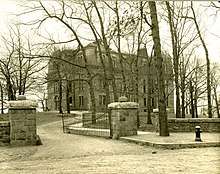
Founded in 1874 as the Massachusetts State Normal School at Worcester, WSU was the fifth of nine teachers training colleges in the state.[2] In the late 19th century Worcester had become a major industrial center and Worcester city officials created a training school for teachers to serve the city's burgeoning public school system. Spurred by the success of this city-run normal school, the Worcester School Committee successfully petitioned the Massachusetts General Court for a state-sponsored teacher training institution in the city.[3] The original campus was located on St. Ann's Hill near the city's downtown where the school's gothic stone classroom building was built in 1874. By 1900, the campus also included a president's house, a women's dormitory called "Stoddard Terrace" and a distinctive turreted gymnasium annex to the main building. This campus would serve WSU for nearly sixty years until the current Chandler Street campus opened in 1932.[4][5][6]
Worcester State’s first “principal” E. Harlow Russell (1874-1909) shaped the school's early curriculum. A pioneer in the Child Study Movement that emphasized childhood development and educational reform efforts, Russell partnered with colleague G. Stanley Hall, later Clark University’s president, to develop a program that placed normal school students in city schools. These student "Apprentices" learned from master teachers and observed and documented child behavior.[7][8]
In the 1920s, Worcester State followed national trends in teacher education by introducing a broader array of college courses and introducing the Bachelor of Science in Education in 1921.[9] The Great Depression threatened the newly-christened Worcester State Teachers College as Massachusetts proposed cost-cutting measures that would eliminate several State Teachers Colleges including Worcester State.[10] Presidents Dr. William B. Aspinwall (1912-1940) and Clinton E. Carpenter (1940-1946) led the college through this crisis and set the stage for post-war development under the presidency of Eugene A. Sullivan (1947-1970).[11][12]
Sullivan oversaw Worcester State's continued expansion of liberal arts and sciences curriculum. In 1952, the college introduced a Master of Science in Education, and in 1963, introduced a Bachelor of Arts degree. Reflecting these curricular changes, the school was renamed Worcester State College that same year.[13] Sullivan also oversaw the development of a collegiate athletic system, introducing varsity sports in 1950 and constructing a new gymnasium building in 1958.[14]
President Robert Leestamper (1970-1975), further expanded graduate programs and introduced professional programs such as nursing and business. The 1970s also saw the creation of Chandler Village (1973), the first residence halls on the Chandler Street campus.[15]
The tenure of Presidents Joseph J. Orze (1975-1982) and Phillip D. Vario (1982-1992) expanded the physical plant with the addition of a Student Center and a new residence hall (Dowden Hall) as well as continued support of varsity sports, and degree offerings in Speech Therapy and Occupational Therapy.[16] The Worcester State Foundation was created in 1994 during the presidency of Kaylan K. Ghosh (1992-2002), to support fundraising for programs and capital improvements. During the following decade, the campus grew to include the new Ghosh Science and Technology Center as well as an additional residence hall and parking structure built during the tenure of president Janelle C. Ashley (2002-2011).[17]
In 2010, the University reorganized into two schools: the School of Humanities and Social Sciences, and the School of Education, Health and Natural Sciences. Later that year, the Massachusetts House and Senate granted Massachusetts State Colleges—including Worcester State—university status.[18]
In 2011, Worcester State installed its 11th President, Barry M. Maloney.[19]
In 2018, the School of Humanities and Social Sciences comprises the departments of Business Administration and Economics, Communication, Criminal Justice, English, History and Political Science, Psychology, Sociology, Urban Studies, Visual and Performing Arts, and World Languages. The School of Education, Health and Natural Sciences comprises the departments of Biology, Chemistry, Communication Sciences and Disorders, Computer Science, Education, Health Science, Mathematics, Nursing, Occupational Therapy, and Earth, Environment, and Physics.
Location
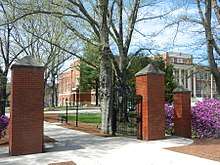
Worcester State University is located on Chandler Street on Worcester's West Side in the Tatnuck neighborhood. The 58-acre campus includes woods and wetlands, and features an east-facing slope with campus buildings built into the hillside.
In the late 19th century, the campus was the site of "Willow Farm", home of William Sever Lincoln (1811-1889), who led the 34th Massachusetts Volunteer Infantry during the American Civil War and was brevetted Brigadier General, US Volunteers in 1865.[20][21] He was the son of Levi Lincoln Jr. (1782-1868), former Massachusetts governor, U.S. representative, and member of the Lincoln family that was prominent in state and national politics during the 19th century.
In 1930, the site was acquired for Worcester State's new campus and, in 1942, an additional 35 acres were added, forming the site's current layout.[22] Until the first residence halls opened in 1973, all students commuted. Today, about 30% of full-time students reside on campus.[23]
Campus buildings
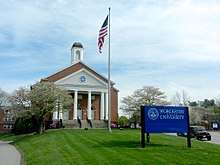 The May Street Building |
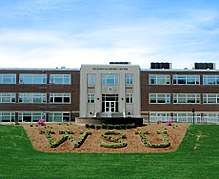 Sullivan Academic Center |
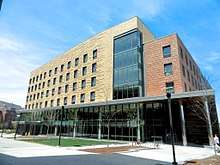 Sheehan Hall |
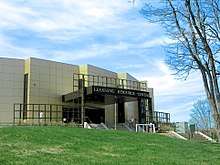 Learning Resource Center |
Ghosh Science and Technology Center: The center features offices, labs and classrooms for Biology, Chemistry, Communication Sciences and Disorders, Computer Science, Earth, Environment, and Physics, Health Sciences, Nursing, and Occupational Therapy. The center also includes the Speech-Language-Hearing Center and the Aisiku STEM Center. The main floor houses the Mary Cosgrove Dolphin Gallery that features rotating visual arts exhibits by students, faculty, and outside artists. The center opened in 2000 and is named for Dr. Kalyan K. Ghosh, the University’s ninth president.
Learning Resource Center: The Learning Resource Center (LRC) includes the University’s library along with classrooms and academic departments. Housed in the LRC are departments for Communication, Criminal Justice, and Visual and Performing Arts, and offices for Information Technology Services and Multicultural Affairs. The building also includes campus Mail Services and Central Receiving. A café is located on the building’s main floor. Located on floors 2 and 3, the Library includes a collection of 200,000 print and electronic items and provides access to printers, copiers, and desktop computers for students and faculty. Completed in 1971, the LRC’s ratchet-shaped building was reclad in its current distinctive metallic siding during renovations in 2010.
May Street Building: This multipurpose building houses classrooms, auditorium spaces, the Department of Sociology, and offices for the Center for Business and Industry. Built in 1949 as the home of Temple Emanuel, a Reform congregation, the University purchased the building in 2015.
Sagamore Studios: The University’s visual arts classes are held in the Sagamore Studios, located in the Worcester Center for Crafts, located at 25 Sagamore Road. The center includes studios for ceramics, glass, and metal, and also hosts public programs. The "New Street Glass Studio" at 35B New Street in Worcester also hosts Worcester State classes and workshops.
Shaughnessy Administration Building: The Helen G. Shaughnessy Administration Building houses administrative offices including the offices of the President and the Provost, and offices for Admissions, Alumni, Development, Financial Aid, Graduate and Continuing Education, Marketing, and the Registrar. The building includes the Fuller Theater, a 166-seat venue created within the campus’ original auditorium. Opened in 1932, the building was the first structure erected on the Chandler Street campus. Named for Helen G. Shaughnessy (’43), renovations carried out in 2007-2009 resulted in LEED Gold certification.[24]
Student Center: The Student Center includes student organization offices, meeting and programming spaces, lounges, and dining areas. Included are offices for Career Services, Commuter Services, International Programs, Military Affairs and Veterans Services, and Student Involvement and Leadership Development. The campus bookstore is located on the ground floor. The building opened in 1978, replacing student facilities housed in the former gymnasium building.
Sullivan Academic Center: The center houses classrooms and offices for multiple academic departments. Included are Business and Economics, Education, English, History and Political Science, Mathematics, Philosophy, Psychology, Sociology, and Urban Studies. The center also includes Sullivan and Eager Auditoriums seating 1,000 and 185, respectively. Opened in 1966 as the Science Building, it was rechristened the Dr. Eugene A. Sullivan Building in 1980 in honor of the University's fifth president.
Wellness Center: The center features competition and multipurpose gymnasiums, a walking track, a fitness center, exercise rooms, and a golf simulator. Included are offices for the Department of Athletics. It is home to the University’s basketball, indoor track and field, and volleyball teams. Opened in 2016, the building replaced the former gymnasium building built in 1958 on the same site. In 2017, the building received LEED gold certification.[25]
Residence Halls: The University’s residence halls – Chandler Village, Dowden Hall, Sheehan Hall, and Wasylean Hall – can house 1,600 students. The buildings are grouped together on the west side of campus and include facilities for dining, recreation, and health services.
- Chandler Village is an apartment-style complex that accommodates 420 students in units ranging from 4 to 11 beds each. Opened in 1973, Chandler Village was the first student housing built on the University’s Chandler Street campus.
- Dowden Hall opened in 1990 and was named for Vera M. Dowden, a former member of the University’s Education faculty. The building was expanded in 2010 to include space for 177 students, and in 2011, it received LEED gold certification.[26]
- Sheehan Hall houses 400 students in suites. The hall also houses the main campus dining hall as well as Health Services, the Office of Residence Life and Housing, and recreational facilities. Opened in 2014, the building is named for Lt. Col. James F. Sheehan, USMC, (’55). The building received LEED Gold certification in 2017.[27]
- Wasylean Hall is a residence hall accommodating 350 students in suites. The Worcester State University Police station is located on the ground floor. Completed in 2004, the building is named for Phillip M. Wasylean II (’63). In 2005, the building received the Honor Award for Design Excellence from the AIA of Central Massachusetts.[28]
Athletics

Worcester State University Athletics is a Division III member of the National Collegiate Athletic Association (NCAA) in the Massachusetts State Collegiate Athletic Conference (MASCAC).
The Worcester State University athletic department currently sponsors men's intercollegiate baseball, basketball, cross country, football, golf, ice hockey, indoor and outdoor track and field, and soccer, and women's intercollegiate basketball, cheerleading, cross country, field hockey, indoor and outdoor track and field, lacrosse, soccer, softball, tennis, and volleyball. Intramural sports offered at WSU include coed soccer, coed flag football, street hockey, dodgeball, wiffle ball, floor hockey, stickball, indoor soccer, ultimate, and softball.
Awards
- Worcester State University was named a "Best Northeastern College" by The Princeton Review for 2018.[29]
- WSU made the President's Community Service Honor Roll for Higher Education in 2009, 2010, 2012, 2013, and 2014.[30]
- WSU was ranked the 113th Best Regional University in the U.S. News & World Report Best Colleges: 2017 Edition.[31]
- WSU was named A Most Environmentally Responsible College by The Princeton Review's Guide to Green Colleges in 2010, 2011, 2014, 2015, 2016, and 2017.[32]
- WSU was voted "Best College in Worcester" by Worcester Magazine from 2006-2017.[33]
- WSU was voted Best Local College in The Landmark Readers' Choice poll in 2009, 2010, 2011, 2012, 2013, 2014, 2015, 2016, and 2017.[34]
- WSU was named one of "America's Best Value Colleges" by The Princeton Review in 2007, 2013, and 2014.[35]
Notable alumni
- Tyler Boudreau, Class of 1997, American author who writes about his experiences in the Marine Corps and in the Iraq War, especially the impact the war had on himself and the other Marines. Boudreau served for twelve and a half years of active duty in the United States Marine Corps.
- Lieutenant General Kevin T. Campbell (ret.), Class of 1973, commanding general of the U.S. Army Space and Missile Defense Command; commanding general of the Joint Functional Component Command for Integrated Missile Defense; and interim commanding general of the U.S. Army Cyber Command. He assumed command of the U.S. Army Space and Missile Defense Command on December 18, 2006, replacing Lieutenant General Larry J. Dodgen. He retired from the Army in 2011.
- Mark J. Carron, (attended), member of the Mass. House of Representatives (served 1999 - 2007)
- John Dufresne, American author of French Canadian descent born in Worcester, Massachusetts. He graduated from Worcester State College in 1970 and the University of Arkansas in 1984. [1] He is a professor in the Master of Fine Arts Creative Writing program of the English Department at Florida International University.
- Mary Fell, Class of 1969, American poet and academic.
- Daniel Garvey, Class of 1973, American academic and administrator. He is president of Prescott College in Arizona.
- Todd J. Leach, Class of 1983, chancellor of the University System of New Hampshire. He received a Distinguished Alumni Award for Outstanding Achievement in the Field of Education Award from Worcester State University in 2012.
- Raymond Mariano, better known as Ray Mariano, Class of 1973, is the current Executive Director of the Worcester Housing Authority. Prior to his service as Executive Director of the WHA, Ray served as Mayor of Worcester, Massachusetts.
- Don Nardo, historian, composer, and writer.
- Brian Skerry, Class of 1985, photojournalist who works all over the world, mainly with National Geographic.
- Sarah Ella Wilson, Class of 1894, educator and clubwoman
- Geoffrey Zakarian, Class of 1981, world-famous chef who has made a name for himself in American cuisine by opening restaurants all around the world. He is an Iron Chef, a regular judge on Food Network's Chopped, co-host of Food Network's The Kitchen, and the host of Sirius XM’s Food Talk radio show.
- Felicia Rose, Class of 2009, wrestling manager and host of The Screw podcast. Felicia skyrocketed to fame after NXT TakeOver Brooklyn in late 2015, posing with a sign imploring facial copulation with wrestler Finn Balor. She currently sits at the top of searches on the ManyVids adult video hosting site.
References
- ↑ "Worcester State University Foundation Board Report, 2017". Worcester State University Foundation. Retrieved 24 July 2018.
- ↑ Rice, Franklin P. "The Worcester of 1898" F.S. Blanchard, 1899. p.192.
- ↑ Massachusetts State University Council of Presidents (2014). Breitborde, Mary-Lou, ed. Remembering Massachusetts State Normal Schools: Pioneers in Teacher Education. Institute for Massachusetts Studies. p. 100. ISBN 978-0-692-24671-9.
- ↑ Franklin, p.193.
- ↑ "Normal School Hearings". Fitchburg Sentinel (Fitchburg, MA). March 2, 1895.
- ↑ "Old Normal School to be Only Memory". Worcester Telegram (Worcester, MA). October 9, 1951.
- ↑ Franklin, p.193-194.
- ↑ Breitborde, p.100-101.
- ↑ Worcester State University History
- ↑ Breitborde, p. 103-104
- ↑ Conroy, Thomas G. (2018). Worcester State University. Charleston, SC: Arcadia Publishing. pp. 24–26. ISBN 978-1-4671-2844-5.
- ↑ Breitborde, 103
- ↑ Conroy, p. 8.
- ↑ Conroy, p.15, 28, 83
- ↑ Conroy, p. 57
- ↑ Conroy, 31
- ↑ Conroy, 34
- ↑ http://news.worcester.edu/governor-patrick-signs-historic-university-status-bill/
- ↑ "Westfield's Loss is Worcester's Gain". Worcester Business Journal. New England Business Media. Retrieved 25 June 2018.
- ↑ Conroy, p. 14
- ↑ "William Sever Lincoln". Find-a-Grave. Retrieved 20 June 2018.
- ↑ Conroy, p. 14
- ↑ "Residence Life". Worcester State University. Retrieved 20 June 2018.
- ↑ "Worcester State University Shaughnessy Administration Building Renovation". MDS Architecture and Planning. MDS/Miller Dyer Spears. Retrieved 19 June 2018.
- ↑ "State Owned LEED-Certified buildings" (PDF). Commonwealth of Massachusetts. Retrieved 19 June 2018.
- ↑ "State Owned LEED-Certified Buildings" (PDF). Commonwealth of Massachusetts. Retrieved 20 June 2018.
- ↑ "State Owned LEED-Certified Buildings" (PDF). Commonwealth of Massachusetts. Retrieved 20 June 2018.
- ↑ "Awards". McNamara-Salvia Structural Engineers. McNamara-Salvia.
- ↑ http://www.worcester.edu/awards
- ↑ "Higher Education Community Service Honor Roll". Corporation for National and Community Service. Retrieved 20 June 2018.
- ↑ "U.S. News & World Report Releases 2017 Best Colleges Rankings". U.S. News and World Report L.P. Retrieved 19 June 2018.
- ↑ "Guide to Green Colleges". TPR Education IP Holdings Inc. Retrieved 19 June 2018.
- ↑ "Best of Worcester 2017". Worcester Magazine, INC. Retrieved 20 June 2018.
- ↑ "Readers Choice, 2017". The Holden Landmark Corporation. Retrieved 20 June 2018.
- ↑ "Best Value Colleges for 2014". TPR Education IP Holdings. Retrieved 20 June 2018.